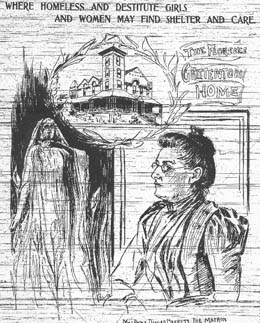On November 21, 1899, the Florence Crittenton Home for unwed mothers opens six miles south of Seattle in Dunlap. The home is part of the women's rescue movement that provides rehabilitation for prostitutes and a safe haven for destitute women. It is the only secular facility for unwed mothers in Seattle. The institution will operate on the same site until 1973.
Named for a Daughter
The Florence Crittenton homes were founded by Charles Crittenton, a wealthy New York druggist who opened a home to care for young prostitutes in New York in 1883. He named the National Florence Crittenton Mission after his 4-year-old daughter, who died of scarlet fever in 1882. Crittenton opened homes in 50 U.S. cities and he came to Seattle in 1899 to open one here. He organized a board of 14 trustees who purchased a 27-room house near the community of Dunlap for $4,100. Facilities included two maternity wards and room for 50 women. "It should not be supposed that it is necessarily a refuge only for fallen women. It is intended as much for girls who are homeless and ill or are otherwise in danger of going to the bad" (Seattle Post-Intelligencer).
The first director, or matron, was Anna Dugas Barrett, who had been active in the rescue movement in Baltimore, Washington, D.C., and New York City. The home received donations from the community; the Plymouth Congregational Church was particularly supportive. Later, the Washington State Legislature provided $1,500 a year. Residents received free medical care, counseling, and free legal advice. Children born to the residents were placed in adoptive homes. The national mission was headed by Kate Harwood Waller Barrett (1857-1925) beginning in 1909 and she helped steer the rescue-home movement away from the reformation of prostitutes and toward the social welfare of the unwed mother.
Another Chance
On March 27, 1926, "The House of Another Chance" (The Seattle Times) opened its new three-story building with room for 150 women. On July 28, 1943, as part of the effort for World War II, the home was leased to the Seattle Health Department to house female prisoners suffering from venereal disease. At that time, 63 out of 80 women inmates were in the city jail "in connection with venereal disease" (The Seattle Times).
In 1949, a young woman at the home told a reporter, "Sure, I'm going to have an illegitimate baby, and I am ashamed. But I would tell the whole world about myself if I thought I could help other girls escape the six months of hell I went through." The Seattle Post-Intelligencer printed a photograph of two of the women from behind and captioned, "This is as close as one can go in showing they are normal-appearing, attractive young people."
The home opened a new wing in 1953, increasing capacity to 200. In 1965, there was a waiting list for beds. Many came from outside King County and out of state. "These girls want a place to go where they're not known," explained director Alice Overton.
Changing Times
By 1971, things had changed. The number of teenagers "in the house" dropped from 73 in January to 23 in June. Society had come to accept unwed mothers and those who came into the group-living situation disliked the structure. Overton said, "They rebel against authority and in any group living situation you have to have rules and regulations for the good of everyone" (Seattle Post-Intelligencer).
In 1973, United Way stopped funding the Florence Crittenton Home because of lack of need. The foundation was $153,000 in debt and had no funds. On March 15, 1973, the facility at 9236 Renton Avenue S closed.
In 1997, the Seattle Indian Health Board began operating the Thunderbird Treatment Center in the building. Thunderbird provides inpatient and outpatient treatment for teen and adult Native Americans suffering from chemical substance abuse.

